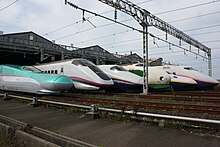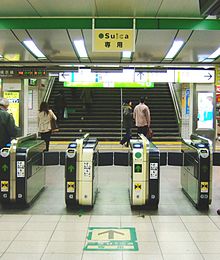East Japan Railway Company
| File:Jreast logo.jpg | |
| Company type | Public KK (TYO: 9020) |
|---|---|
| Industry | Private railroad |
| Predecessor | Japan National Railways (JNR) |
| Founded | April 1, 1987 (privatization of JNR) |
| Headquarters | , Japan |
Area served | Kantō and Tōhoku regions Niigata, Nagano, Yamanashi and Shizuoka prefectures |
Key people | Mutsutake Ōtsuka, Chairman Satoshi Seino (ja:清野智), President |
| Products | Suica (a rechargeable contactless smart card) |
| Services | passenger railways [1] freight services [1] bus transportation [1] other related services [1] |
| Revenue | |
| Total assets | |
| Total equity | |
| Owner | Japan Trustee Services Bank (6.61%)[3] The Master Trust Bank of Japan (4.93%)[3] The Bank of Tokyo-Mitsubishi UFJ (3.13%)[3] Sumitomo Mitsui Banking Corporation (2.63%)[3] Mizuho Corporate Bank (2.50%)[3] Mizuho Bank (2.50%)[3] The JR East Employees Shareholding Association (2.46%)[3] Nippon Life (2.00%)[3] Dai-ichi Life (1.78%)[3] (as of March 31, 2009) |
Number of employees | 61,900 (as of April 1, 2008)[1] |
| Divisions | Railway operations [4] Life-style business [4] IT & Suica business[4] |
| Subsidiaries | 83 companies,[5]
[6] including Tokyo Monorail |
| Website | www.jreast.co.jp |
| East Japan Railway Company | |||||
|---|---|---|---|---|---|
 JR East Shinkansen 200 ~ E5 Series | |||||
| Operation | |||||
| National railway | Japan Railways Group | ||||
| Infrastructure company | Japan Railway Construction, Transport and Technology Agency | ||||
| Statistics | |||||
| Ridership | 6.169 billion per year[6] | ||||
| Passenger km | 130.5 billion per year[6] | ||||
| System length | |||||
| Total | 7,526.8 km (4,676.9 mi)[6] | ||||
| Double track | 3,668 km (2,279 mi) (49%)[6] | ||||
| Electrified | 5,512.7 km (3,425.4 mi) (73.2%)[6] | ||||
| High-speed | 1,052.9 km (654.2 mi) (14.0%)[6] | ||||
| Track gauge | |||||
| Main | 1067 | ||||
| High-speed | 1,435 mm (4 ft 8+1⁄2 in) | ||||
| Electrification | |||||
| Main | 1,500 V DC overhead catenary 2,680.3 km (1,665.5 mi)[6] | ||||
| 20 kV AC 50 Hz | 1,779.5 km (1,105.7 mi)[6] Conventional lines in Tohoku Joban Line (Fujishiro-Iwanuma) Mito Line | ||||
| 25 kV AC 50 Hz/60 Hz overhead | 1,052.9 km (654.2 mi)[6] Tohoku Shinkansen (50 Hz) Joetsu Shinkansen (50 Hz) Nagano Shinkansen (50 Hz/60 Hz) | ||||
| Features | |||||
| No. tunnels | 1,263[6] | ||||
| Tunnel length | 882 km (548 mi)[6] | ||||
| Longest tunnel | The Iwate-Ichinohe Tunnel 25,808 m (84,672 ft) Tohoku Shinkansen[6] | ||||
| No. bridges | 14,865[6] | ||||
| Longest bridge | No.1 Kitakami River Bridge 3,868 m (12,690 ft) Tohoku Shinkansen[6] | ||||
| No. stations | 1,703[1] | ||||
| |||||
East Japan Railway Company (東日本旅客鉄道株式会社, Higashi-Nihon Ryokaku Tetsudō Kabushiki-gaisha) is the largest passenger railway company in the world and one of the seven Japan Railways Group companies. The company name is officially abbreviated as JR East in English, and as JR Higashi-Nihon (JR東日本) in Japanese. The company's headquarters are in Yoyogi, Shibuya, Tokyo.[1]





History
JR East was incorporated on April 1, 1987 after being spun off from the government-run Japanese National Railways. The spin-off was nominally "privatization", as the company was actually a wholly owned subsidiary of the government-owned JNR Settlement Corporation for several years, and was not completely sold to the public until 2002.
Following the breakup, JR East ran the operations on former JNR lines in the Greater Tokyo Area, the Tōhoku region, and surrounding areas.
Lines
Its railway lines primarily serve Kantō and Tōhoku regions, along with adjacent areas in Niigata, Nagano, Yamanashi and Shizuoka prefectures.
Shinkansen
JR East operates all of the Shinkansen, high speed rail lines, north of Tokyo.
- Akita Shinkansen (Morioka - Akita)
- Nagano Shinkansen (Tokyo - Nagano)
- Jōetsu Shinkansen (Tokyo - Niigata)
- Tōhoku Shinkansen (Tokyo - Sendai - Hachinohe - Shin Aomori)
- Yamagata Shinkansen (Fukushima - Shinjō)
The Tokyo–Osaka Tōkaidō Shinkansen is owned and operated by the Central Japan Railway Company, although it stops at several JR East stations.
Kantō regional lines
Greater Tokyo Area
These lines have sections inside the Tokyo Suburban Area (東京近郊区間) designated by JR East. This does not necessarily mean that the lines are fully inside the Greater Tokyo Area.
- ■ Chūō Main Line (Tokyo - Nirasaki[citation needed])
- ■ Chūō Rapid Line (Tokyo - Takao - Ōtsuki)
- ■ Chūō-Sōbu Line (Mitaka - Shinjuku - Chiba)
- ■ Hachikō Line (Hachiōji - Takasaki)
- ■ Itsukaichi Line (Haijima - Musashi-Itsukaichi)
- ■ Jōban Line (Ueno - Takahagi)
- ■ Jōetsu Line (Takasaki - Minakami)
- ■ Kawagoe Line (Ōmiya - Kawagoe - Komagawa)
- ■ Keihin-Tōhoku Line (Ōmiya - Tokyo - Yokohama)
- ■ Keiyō Line (Tokyo - Soga)
- ■ Mito Line (Oyama - Tomobe)
- ■ Musashino Line (Fuchū-Hommachi - Nishi-Funabashi) (Tokyo outer loop)
- ■ Nambu Line (Kawasaki - Tachikawa; Shitte - Hamakawasaki)
- ■ Narita Line (Sakura - Chōshi; Abiko - Narita; Narita - Narita Airport)
- ■ Negishi Line (Yokohama - Ōfuna)
- ■ Ōme Line (Tachikawa - Ōme - Okutama)
- ■ Ryōmō Line (Oyama - Shin-Maebashi)
- ■ Sagami Line (Hashimoto - Chigasaki)
- ■ Saikyō Line (Ōsaki - Ōmiya) (■ Old Akabane Line (Ikebukuro - Akabane))
- ■ Shōnan-Shinjuku Line (Ōmiya - Shinjuku - Ōfuna)
- ■ Sōbu Main Line (Tokyo - Chōshi)
- ■ Sotobō Line (Chiba - Mobara - Awa-Kamogawa)
- ■ Takasaki Line (Ōmiya - Takasaki)
- ■ Tōgane Line (Narutō - Ōami)
- ■ Tōhoku Main Line (Utsunomiya Line) (Ueno - Kuroiso)
- ■ Tōkaidō Main Line (Tōkyō - Yokohama - Atami)
- ■ Tsurumi Line (Tsurumi - Ōgimachi; Anzen - Ōkawa; Asano - Umi-Shibaura)
- ■ Uchibō Line (Soga - Kisarazu - Awa-Kamogawa)
- ■ Yamanote Line (Ōsaki - Shinjuku - Tabata - Tokyo - Ōsaki)
- ■ Yokohama Line (Higashi-Kanagawa - Hachiōji)
- ■ Yokosuka Line (Tokyo - Kurihama)
- Nikkō Line (Utsunomiya - Nikkō)
Other lines in Kantō
- Karasuyama Line (Karasuyama - Hōshakuji)
- ■ Kashima Line (Katori - Kashima Soccer Stadium)
- ■ Kururi Line (Kisarazu - Kazusa-Kameyama)
Tōkai and Kōshinetsu regional lines
- ■ Agatsuma Line (Shibukawa - Ōmae)
- ■ Chūō Main Line (Nirasaki - Shiojiri)
- ■ Echigo Line (Niigata - Kashiwazaki)
- ■ Hakushin Line (Niigata - Shibata)
- ■ Iiyama Line (Toyono - Echigo-Kawaguchi)
- Itō Line (Atami - Itō) (treated as Tokyo Suburban Area lines)
- ■ Jōetsu Line (Shibukawa - Miyauchi; Echigo-Yuzawa - Gala-Yuzawa)
- Koumi Line (Kobuchisawa - Komoro)
- ■ Ōito Line (Matsumoto - Minamiotari)
- ■ Shin'etsu Main Line (Takasaki - Yokokawa; Shinonoi - Nagano - Niigata)
- ■ Shinonoi Line (Shinonoi - Shiojiri)
- ■ Yahiko Line (Higashi-Sanjō - Yahiko)
Tōhoku regional lines
- Aterazawa Line (Kita-Yamagata - Aterazawa)
- ■ Ban'etsu East Line (Iwaki - Kōriyama)
- ■ Ban'etsu West Line (Kōriyama - Niitsu)
- Gonō Line (Higashi-Noshiro - Kawabe)
- Hachinohe Line (Hachinohe - Kuji)
- ■ Hanawa Line (Ōdate - Kōma)
- ■ Ishinomaki Line (Kogota - Onagawa)
- ■ Iwaizumi Line (Moichi - Iwaizumi)
- ■ Jōban Line (Takahagi - Iwanuma)
- ■ Kamaishi Line (Hanamaki - Kamaishi)
- ■ Kesennuma Line (Maeyachi - Kesennuma)
- ■ Kitakami Line (Kitakami - Yokote)
- ■ Ōfunato Line (Ichinoseki - Sakari)
- Oga Line (Oiwake - Oga)
- Ōminato Line (Noheji - Ōminato)
- Ōu Main Line (Fukushima - Yamagata - Akita - Aomori)
- ■ Rikuu East Line (Kogota - Shinjō)
- ■ Rikuu West Line (Shinjō- Amarume)
- ■ Senseki Line (Aobadōri - Ishinomaki)
- ■ Senzan Line (Sendai - Uzen-Chitose)
- ■ Suigun Line (Mito - Asaka-Nagamori; Kamisugaya - Hitachi-Ōta)
- ■ Tadami Line (Aizu-Wakamatsu - Koide)
- ■ Tazawako Line (Morioka - Ōmagari)
- ■ Tōhoku Main Line (Kuroiso - Morioka; Hachinohe - Aomori; Iwakiri - Rifu)
- Tsugaru Line (Aomori - Mimmaya) (a part of Tsugaru-Kaikyō Line)
- Tsugaru-Kaikyō Line (Aomori - Nakaoguni)
- ■ Uetsu Main Line (Niitsu - Akita)
- ■ Yamada Line (Morioka - Kamaishi)
- ■ Yonesaka Line (Yonezawa - Sakamachi)
Train services
Below is the full list of limited express (including Shinkansen) and express train services operated on JR East lines as of 2008.
Shinkansen
- Asama
- Hayate
- Komachi
- Nasuno/Max Nasuno
- Tanigawa/Max Tanigawa
- Toki/Max Toki
- Tsubasa
- Yamabiko/Max Yamabiko
Limited express (daytime)
- Akagi/Weekend Akagi
- Ayame
- Super Azusa/Azusa
- Hakuchō/Super Hakuchō
- Hakutaka
- Super Hitachi/Fresh Hitachi
- Inaho
- Kaiji
- Kamoshika
- Kinugawa/Spacia Kinugawa
- Kusatsu
- Minakami
- Narita Express
- Nikkō
- Super View Odoriko/Odoriko
- Sazanami
- Wide View Shinano/Shinano
- Shiosai
- Ohayō Tochigi/Hometown Tochigi
- Tsugaru
- Wakashio
Limited express (overnight)
- Akebono
- Cassiopeia
- Fuji
- Hayabusa
- Hokuriku
- Hokutosei
- Nihonkai
- Sunrise Izumo/Sunrise Seto
- Twilight Express
Express
All remaining express services operated on JR East tracks are overnight expresses (夜行急行列車, yakō kyūkō ressha).
Subsidiaries

- Higashi-Nihon Kiosk - provides newspapers, drinks and other items in station kiosks and operates the Newdays convenience store chain
- JR Bus Kantō / JR Bus Tōhoku - intercity bus operators
- Nippon Restaurant Enterprise - provides bentō box lunches on trains and in train stations
- Tokyo Monorail - (70% owned)
Sponsorship
JR East co-sponsors the JEF United Ichihara Chiba J-League soccer club, which was formed by a merger between JR East and Furukawa Electric company teams.
Environmental issues
JR East aims to reduce its carbon emissions by half, as measured over the period 1990-2030. This would be achieved by increasing the efficiency of trains and company-owned thermal power stations and by developing hybrid trains[7].
East Japan Railway Culture Foundation
The East Japan Railway Culture Foundation is a non-profit organization established by JR East for the purpose of developing a "richer railway culture".[8] The Railway Museum in Saitama is operated by the foundation.
References
- ^ a b c d e f g East Japan Railway Company. "JR East Corporate Data". Retrieved 20 June 2009.Template:En icon
- ^ a b c d e East Japan Railway Company. "Consolidated Results of Fiscal 2009 (Year Ended March 31, 2009)" (PDF). Retrieved 20 June 2009.Template:En icon
- ^ a b c d e f g h i East Japan Railway Company. "Business Report for the 22nd Fiscal Year" (PDF). Retrieved 20 June 2009. [dead link]Template:En icon
- ^ a b c East Japan Railway Company. "Organization". Retrieved 20 June 2009.Template:En icon
- ^ East Japan Railway Company. "グループ会社一覧". Retrieved 20 June 2009.Template:Ja icon
- ^ a b c d e f g h i j k l m n o East Japan Railway Company. "会社要覧2008" (PDF). Retrieved 20 June 2009.Template:Ja icon
- ^ 'JR East Efforts to Prevent Global Warming' in Japan Railway & Transport Review No. 51 (pp.22–27), retrieved 2010-12-15
- ^ East Japan Railway Culture Foundation. "FOR A RICHER RAILWAY CULTURE". Retrieved 28 October 2007.
External links
![]() Media related to JR East at Wikimedia Commons
Media related to JR East at Wikimedia Commons
